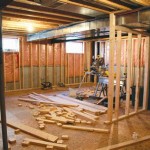Can You Put A Bathroom In A Basement
Installing a bathroom in the basement can be an excellent method to add value and functionality to your home. However, homeowners should consider several factors during the planning and installation phases to ensure a successful project.
1. Plumbing Considerations:
Ensuring proper drainage is crucial. The basement floor must be sloped toward the drain to prevent water from pooling. The drainpipe should also be large enough to handle the water flow from the bathroom fixtures. Additionally, hot and cold water lines must be extended from the main water supply to the bathroom location.
2. Ventilation Requirements:
Bathrooms produce moisture, making proper ventilation essential. Installing an exhaust fan is vital to remove moisture and prevent mold growth. The fan should be vented directly to the outside, and the ductwork should be properly sized to ensure adequate airflow.
3. Electrical Needs:
Electrical wiring is necessary for lighting, outlets, and bathroom fixtures. A licensed electrician should install all electrical components according to building codes. Proper grounding and circuit protection are crucial for safety.
4. Building Codes and Permits:
Before starting any bathroom installation, it's essential to check local building codes and obtain the necessary permits. These regulations ensure that the bathroom meets safety and sanitation standards. Failure to comply can result in fines or even a stop-work order.
5. Space and Layout:
The size and layout of the basement will determine the bathroom's design. Consider the placement of fixtures, such as the toilet, sink, and shower, to optimize space utilization. Adequate headroom and accessibility for maintenance are also important factors.
6. Waterproofing and Moisture Control:
Basements are prone to moisture, so waterproofing is crucial. Installing a vapor barrier on the walls and floor will prevent moisture from penetrating the bathroom. Additionally, using moisture-resistant materials, such as tile or vinyl flooring, is recommended to minimize water damage.
7. Lighting and Natural Light:
Proper lighting is essential for a comfortable and functional bathroom. Natural light, if available, should be maximized through windows or skylights. Artificial lighting should be well-distributed and provide adequate illumination for all areas of the bathroom.
8. Cost and ROI:
The cost of installing a basement bathroom can vary depending on the size, materials, and labor involved. The project's return on investment (ROI) is also a consideration. A well-designed and executed bathroom can increase the value of your home and make it more desirable to potential buyers.
9. Professional Installation:
While some homeowners may have the skills to install a bathroom themselves, it's generally recommended to hire a qualified contractor. Professionals have the knowledge, experience, and tools to ensure that the bathroom is installed correctly and meets all building codes and safety standards.
In conclusion, installing a bathroom in a basement can be a valuable addition to your home. Careful planning, adherence to building codes, and professional installation are crucial for a successful project. By considering the factors discussed above, you can create a functional, comfortable, and aesthetically pleasing bathroom that will enhance the livability and value of your home.
How To Plumb A Basement Bathroom Diy Family Handyman

How To Install A Basement Bathroom 2024 Quick Guide

How To Diy Bathroom In Basement Without Breaking Concrete

Adding A Bathroom To Basement Pros Cons Costs

Adding A Basement Bathroom What You Need To Know Make It Right

How To Finish A Basement Bathroom Before And After S

Should You Install A Bathroom In Your Finished Basement 2024 Design Plumbing

Basement Bathroom Plumbing Planning For A Below Grade Lavatory

A Basement Bathroom Renovation Merrypad

How To Finish A Basement Bathroom Pex Plumbing








